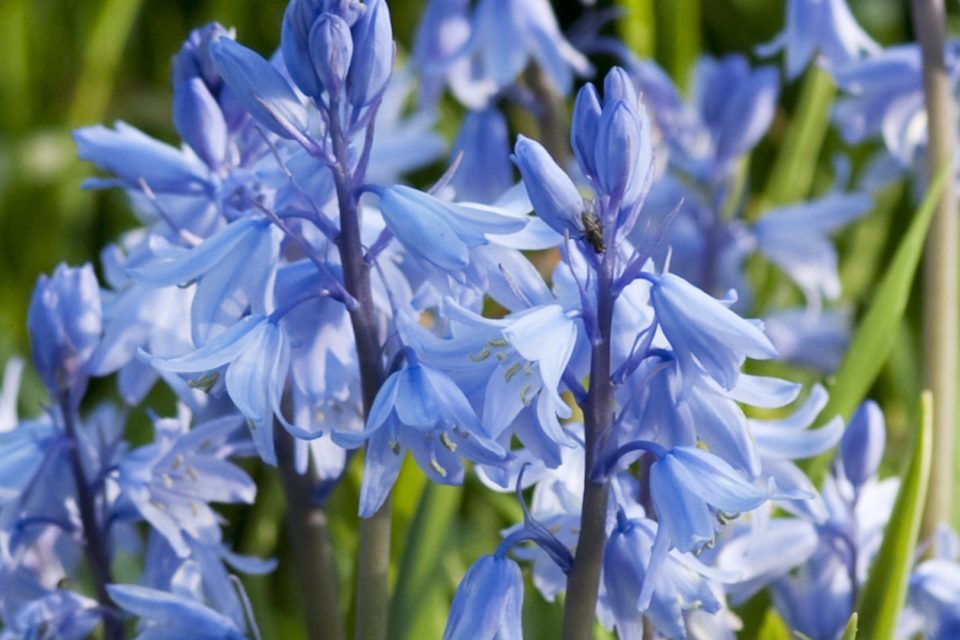Seeing bluebells scattered along a grassy verge or carpeting a woodland floor has to be a highlight of any spring walk
“There is a silent eloquence
In every wild bluebell
That fills my softened heart with bliss
That words could never tell.”
From The Bluebell by Anne Bronte

© National Trust/Justin Minns
These delicate blooms can be found across Western Europe, but about half of the world’s population grows in the UK. They also grow well in shady garden corners and pots, so why not try creating your own mini bluebell wood at home?
Bluebells take a long time to get established, so if you come across a thick swathe of them it’s often a sign that you’re walking through an ancient woodland. National Trust rangers and gardeners take great care of these special flowers.
Bluebells are delicate and easily damaged, especially if they’re trodden on. Damage can prevent the leaves from photosynthesizing, causing the plant to die back. Bluebells take between five and seven years to get established, so minor damage can have long-lasting impact. Help to look after the bluebells by watching where you tread, and sticking to marked pathways.
Bluebells are vital to keeping woodland ecosystems going. Bees, butterflies and hoverflies are all attracted to them – the striking blue and purple colors stand out among the greenery of woodlands, making them easy to spot for these pollinators.

©National Trust/Andrew Butler
How to tell the difference between English and Spanish bluebells
Hyacinthoides non-scripta bluebells are native to the UK, but they’re under threat from the non-native Spanish bluebell (Hyacinthoides hispanica) which was introduced to Britain around the late 17th century. In the last thirty years the Spanish bluebell has escaped from gardens and begun to mix with native bluebells. It’s fairly easy to tell the difference between English and Spanish bluebells, but the hybrids can be trickier as they take characteristics from both.
- Flower and Stem: Native bluebells are narrow with straight sides, and the petals curl back at the tips. The stem droops over at the top, with most of the flowers on one side. Spanish bluebells are cone-shaped, and their petal tips tend to be flared rather than curling. The stems are straight, with flowers all the way round.
- Pollen color: Look at the pollen inside the flower. If it’s creamy-white, then the bluebell is probably a native (or a hybrid). If the pollen is green our blue, it’s not native.
- Flower color: Native bluebells are usually a deep blue-violet shade, while Spanish ones tend to be paler. Confusingly. Both varieties also come in white and pink.
- Scent: Native bluebells have a strong, sweet scent, which gives the woods a wonderful fragrance on a warm day. The Spanish variety has little to no scent.
- Leaves: Native bluebells have relatively thin leaves, around 1-1.5 cm wide. Spanish and hybrid bluebells tend to have much thicker leaves, around 3cm wide.

© National Trust Images
Top tips from National Trust gardeners
- Bluebell seeds can take four to five years to reach flowering size, so it’s better to buy bulbs. In spring you can get bluebells ‘in the green’ i.e. while they’re flowering, which many gardeners believe will have a better chance of getting established. Alternatively, you can buy them as dry bulbs to plant in autumn.
- Bluebells are woodland plants, so they grow best in partial shade with moist but well-drained soil. Adding leaf mould, manure or compost to the soil will ensure they have plenty of nutrients. Try planting them in clumps under deciduous trees or shrubs to create a mini-woodland effect.
- Plant ‘in the green’ bluebells at the same depth they were previously grown – you can often see this where the leaf stalks change from white to green. If you’re using dry bulbs place them 10cm deep and 10cm apart, with the pointed tip facing upwards. Water well after planting.
- Bluebells take a while to get established, so don’t be surprised if you only get leaves next year. The plant will be putting most of its energy into producing roots rather than flowers. Leave the foliage to die back rather than cutting it off – the leaves use sunlight to make food which strengthens the plant for the following year.
Take a virtual tour of a bluebell wood
There’s plenty of scientific evidence that being out in nature is beneficial to our health and wellbeing, but recent studies have shown that just looking at images of nature can also help to reduce stress levels. If you’re searching for a way to relax, why not escape to a virtual bluebell wood with the help of this ‘slow TV’ video? Simply put your headphones on and let yourself be transported.



